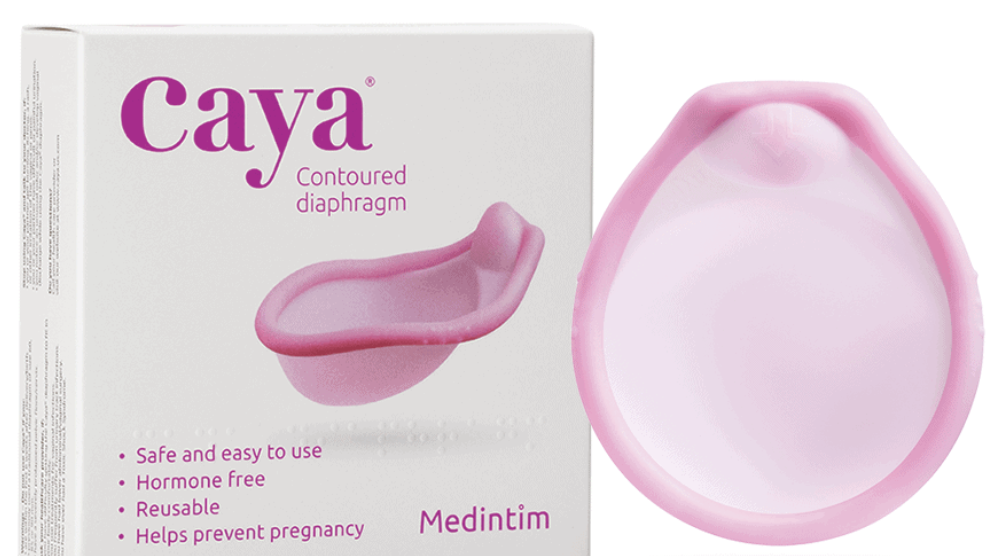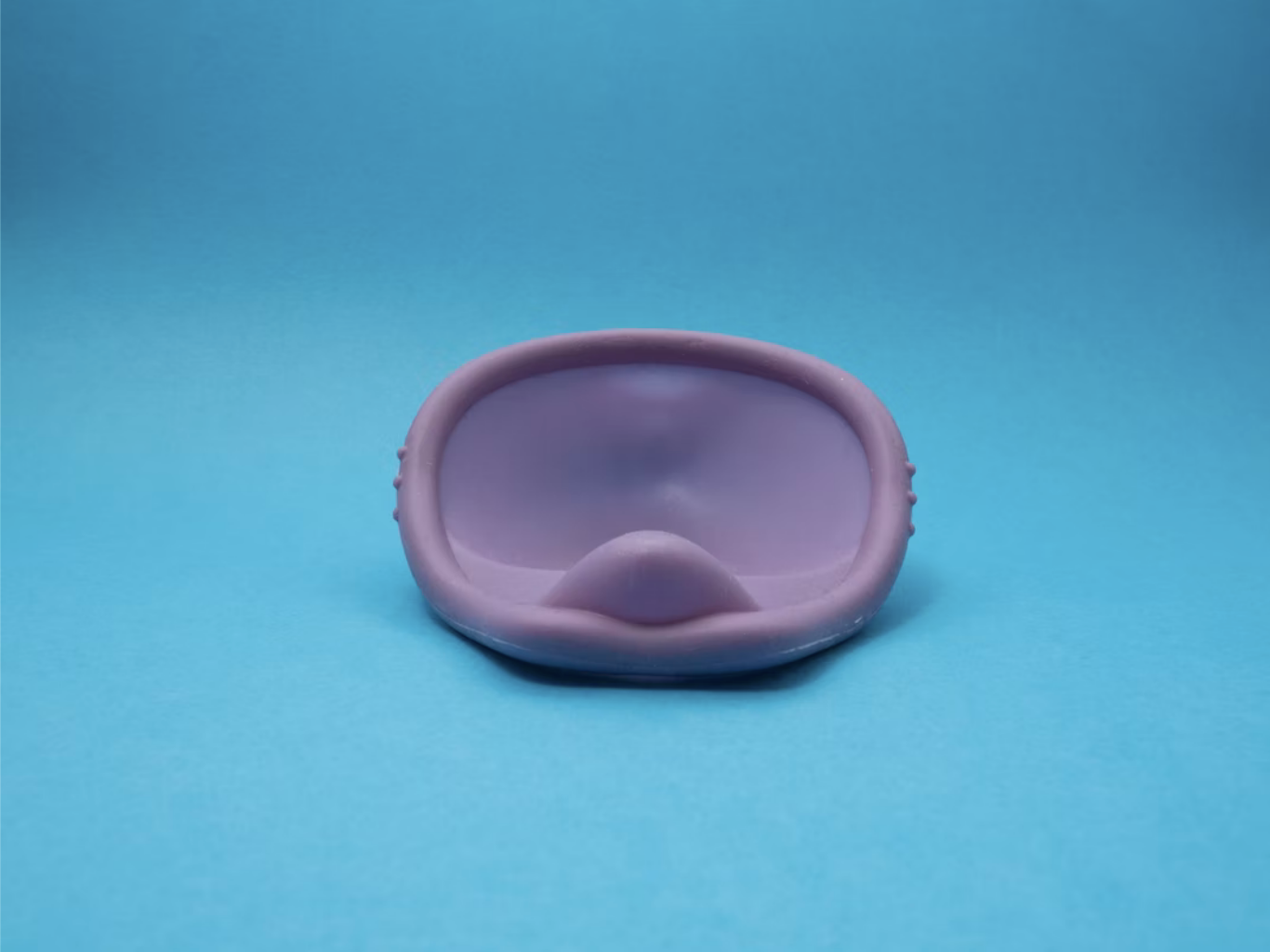Residents of Hawaii seeking a non-hormonal contraceptive option might find the CAYA diaphragm to be an excellent choice. This guide outlines the steps and state-specific requirements to help you obtain the CAYA diaphragm in Hawaii.
To get the CAYA diaphragm in Hawaii, start by scheduling an appointment with a licensed healthcare provider. Hawaii law requires a prescription for the CAYA diaphragm, so you'll need a healthcare professional to assess your suitability for this contraceptive method. During the consultation, your provider will review your health history and explain how the CAYA diaphragm works.

In Hawaii, obtaining the CAYA diaphragm requires a prescription. Once your healthcare provider determines that the CAYA diaphragm is suitable for your contraceptive needs, they will issue a prescription. If your usual provider is unfamiliar with the CAYA diaphragm, you may seek out a clinic or provider specializing in non-hormonal contraception within the state.
With your prescription, the next step is finding a pharmacy in Hawaii that carries the CAYA diaphragm. Not all pharmacies stock it, so calling ahead or searching online for availability is recommended. You can also opt to order the CAYA diaphragm from an online pharmacy that ships to Hawaii.
Hawaii health insurance plans, including those under the Affordable Care Act, often cover contraceptive devices like the CAYA diaphragm. Before purchasing, confirm with your insurance provider if the device is covered. If you're uninsured, Hawaii's Medicaid program or other state-assisted health plans may cover the CAYA diaphragm.
Using the CAYA diaphragm correctly is essential for its effectiveness. Your Hawaii healthcare provider should offer you detailed instructions on how to use the CAYA diaphragm, and online resources are available to help ensure proper usage for maximum contraceptive benefits.
My Virtual Physician offers telehealth appointments for patients interested in the CAYA diaphragm. Schedule your appointment with us today! BOOK HERE
Residents of Connecticut looking for a non-hormonal contraceptive option might find the CAYA diaphragm to be an excellent choice. This guide outlines the steps and state-specific requirements to help you obtain this diaphragm in Connecticut.
To obtain the CAYA diaphragm in Connecticut, you’ll need to schedule an appointment with a licensed healthcare provider. A prescription is required by Connecticut law, so your healthcare professional will assess your health history and ensure that this diaphragm is a good fit for your contraceptive needs. During the visit, your provider will explain how the diaphragm functions and how to use it properly.
In Connecticut, a prescription is necessary to obtain the diaphragm. Once your healthcare provider determines that it’s an appropriate option, they will issue the prescription. If your usual provider is unfamiliar with this diaphragm, consider reaching out to a clinic that specializes in non-hormonal contraception within Connecticut.
 Step 3: Where to Obtain the CAYA Diaphragm in Connecticut
Step 3: Where to Obtain the CAYA Diaphragm in ConnecticutAfter receiving your prescription, you’ll need to locate a pharmacy in Connecticut that carries the diaphragm. Since it might not be available at all pharmacies, it’s a good idea to call ahead or look for availability online. Alternatively, ordering this diaphragm from an online pharmacy that delivers to Connecticut is also an option.
Connecticut health insurance plans, including those provided under the Affordable Care Act, often cover contraceptive devices like the CAYA diaphragm. Be sure to check with your insurance provider to verify coverage. If you are uninsured, Connecticut's Medicaid program or other state health assistance plans may provide coverage for this diaphragm.
Proper usage is critical for the effectiveness of the diaphragm. Your Connecticut healthcare provider will give you instructions on how to use it, and there are online resources available to assist you in ensuring that you are using it correctly to maximize its contraceptive benefits.
My Virtual Physician offers telehealth appointments for patients interested in the CAYA diaphragm. Schedule your appointment with us today! BOOK HERE
 Residents of Colorado seeking a non-hormonal contraceptive option might find the CAYA diaphragm to be an excellent choice. This guide outlines the steps and state-specific requirements to help you obtain this diaphragm in Colorado.
Residents of Colorado seeking a non-hormonal contraceptive option might find the CAYA diaphragm to be an excellent choice. This guide outlines the steps and state-specific requirements to help you obtain this diaphragm in Colorado.
To get this diaphragm in Colorado, start by scheduling an appointment with a licensed healthcare provider. Colorado law requires a prescription, so you'll need a healthcare professional to assess your suitability for this contraceptive method. During the consultation, your provider will review your health history and explain how the diaphragm works.
In Colorado, obtaining this diaphragm requires a prescription. Once your healthcare provider determines that this diaphragm is suitable for your contraceptive needs, they will issue a prescription. If your usual provider is unfamiliar with this diaphragm, you may seek out a clinic or provider specializing in non-hormonal contraception within the state.
With your prescription, the next step is finding a pharmacy in Colorado that carries this diaphragm. Not all pharmacies stock it, so calling ahead or searching online for availability is recommended. You can also opt to order this diaphragm from an online pharmacy that ships to Colorado.
Colorado health insurance plans, including those under the Affordable Care Act, often cover contraceptive devices like this diaphragm. Before purchasing, confirm with your insurance provider if the device is covered. If you're uninsured, Colorado's Medicaid program or other state-assisted health plans may cover this diaphragm.
Using this diaphragm correctly is essential for its effectiveness. Your Colorado healthcare provider should offer you detailed instructions on how to use this diaphragm, and online resources are available to help ensure proper usage for maximum contraceptive benefits.
My Virtual Physician offers telehealth appointments for patients interested in this diaphragm. Schedule your appointment with us today! BOOK HERE
In an era where women's health and comfort are prioritized, the Caya Diaphragm emerges as a significant advancement in contraceptive choices. It's not just about preventing pregnancy; it's about embracing a method that aligns with your lifestyle and well-being. My Virtual Physician recognizes this need and stands ready to guide you through understanding how the Caya Diaphragm can be a game-changer in your sexual health journey.
The design of the Caya Diaphragm is a testament to modern medical ingenuity. Its contoured, silicone-based structure is tailored to fit the female anatomy comfortably. This means no rigid edges or uncomfortable fits – just a natural, almost unnoticeable presence during use. For women who have experienced discomfort with other contraceptive methods, the Caya Diaphragm offers a breath of fresh air. Its material is hypoallergenic, making it suitable for women with sensitivities or allergies to latex.
Moreover, the comfort it provides goes beyond the physical aspect. There’s a mental ease that comes from using a product that’s designed with your body in mind. This can significantly impact your sexual health positively, making intimate moments more enjoyable without the worry of discomfort.
When it comes to contraception, effectiveness is a non-negotiable. The Caya Diaphragm, backed by clinical research, offers impressive reliability. Its design is such that, when used correctly and with spermicide, it forms a physical barrier that prevents sperm from reaching the uterus. This method’s success rate is encouraging, giving women confidence in their contraceptive choice.
It's important to note that the effectiveness of any contraceptive method, including the Caya Diaphragm, depends on proper use. This is where My Virtual Physician comes into play. Our team is dedicated to educating you on the correct usage, ensuring that you get the most out of your Caya Diaphragm.
Choosing a contraceptive method that you're comfortable with can have a profound effect on your sexual well- being and relationship satisfaction. A method that is both comfortable and reliable like the Caya Diaphragm can reduce anxiety around intercourse, leading to a more fulfilling sexual experience. This peace of mind is invaluable, allowing you to focus on the intimacy and connection with your partner.
Furthermore, the Caya Diaphragm does not interfere with the body’s natural hormonal balance. This is a crucial factor for many women who prefer or need to avoid hormonal contraception for various health reasons.
My Virtual Physician’s commitment to empowering women with choices is evident in our support for the Caya Diaphragm. We understand that each woman’s needs are unique, and our approach is to provide personalized consultations. Through telemedicine, access to this modern contraceptive method is simplified, making it a viable option for women everywhere.
Our platform provides not just access but also comprehensive education about the Caya Diaphragm. We believe in informed choices, and our team ensures that you have all the information you need to make the best decision for your health and lifestyle.
The Caya Diaphragm represents more than just a contraceptive method; it's a statement of comfort, reliability, and empowerment. My Virtual Physician is here to help you explore this option, ensuring that your journey in sexual health is supported, informed, and aligned with your personal values. We invite you to schedule an appointment with us for a personalized consultation on using the Caya Diaphragm and to address any sexual health concerns you may have. Remember, your comfort and health are paramount, and with the Caya Diaphragm, you’re choosing a path that respects both.

Giving birth to a new baby is an exciting time and a life-changing experience in a woman’s life. This time is filled with sleepless nights and frustrating moments, but the reward is your precious new child who brings endless love and joy.
Over 80% of newborns are breastfed at some point during their infancy. Mothers naturally desire to breastfeed their newborns, and the US Dietary Guidelines for Americans agree that human breastmilk is the best food for newborns and infants.
If you’ve chosen to breastfeed your baby, you want to make sure you’re providing your baby with milk that is safe for your baby to drink. That means you may have to make some adjustments to avoid contaminating your milk supply. Medications are one way that a mother’s milk supply can be adversely affected.
In this blog, we’ll talk about contraceptive options after giving birth. We’ll cover safe birth control alternatives for breastfeeding mothers.
Related: Breastfeeding in the 21st Century: Setting up for Success
Breastfeeding is natural birth control. That’s because of a natural period of infertility follows childbirth. You can use this phase to your advantage; this contraceptive method is called the lactational amenorrhea method (LAM). You can temporarily use this phase as a birth control method for up to six months if you’re a breastfeeding mother.
There are three criteria that must apply in order to know that you’re protected from pregnancy with LAM. They include:
LAM can be up to 98% effective at preventing pregnancy for the first six months after delivery. However, once the three criteria above are no longer met, you’ll need to switch to another birth control method.
Many birth control methods, including the pill and the shot, are hormone-based. They work by delivering chemicals internally that alter your body’s normal hormone levels, influencing natural processes like suspending ovulation. Hormonal birth control methods can have negative consequences for breastfeeding mothers and infants, including:
Several alternative contraceptive methods are compatible with breastfeeding mothers.
Related: Why Women are Switching to the Diaphragm as a Birth Control Alternative
While you’re still breastfeeding, your best options for birth control after LAM include barrier methods, copper IUDs, and natural family planning methods. These methods have no adverse effect on your milk supply or quality.
Condoms, diaphragms, cervical caps, and spermicides are all methods of birth control that work by creating a physical barrier that blocks sperm from entering the female reproductive system past the cervix. These non-hormonal alternatives work on-demand, as needed before sexual intercourse.
The effectiveness of each method and brand varies, but generally hovers around 80-85%. For example, the Caya diaphragm, which can be used six weeks after childbirth, has an effectiveness of 86% with perfect use and 82% with typical use.
If you’re interested in seeing if a diaphragm is right for you as a breastfeeding mother, My Virtual Physician has partnered with Caya to provide this hassle-free contraceptive option to our patients. Schedule an appointment today to find out.
An intrauterine device (IUD) is a small T-shaped medical device that is inserted into the uterus by a doctor. The non-hormonal version of the device, branded as Paragard, prevents pregnancy by making the conditions inside the uterus unfavorable for sperm and therefore preventing fertilization. These devices can be very effective at over 99% and can be left in place for up to a decade. After having a baby, you’ll have two windows of opportunity to have Paragard inserted:
Keep in mind, though, that the risk of Paragard becoming embedded in the uterus increases for breastfeeding mothers.
If you’re looking for a completely natural method of birth control while you breastfeed, you do have one more option on the table: fertility awareness. This method, abbreviated as FAM or FAB, involves tracking your menstrual cycles to determine your fertility window. During your fertility window, you can prevent pregnancy by avoiding sex or using a barrier method, such as condoms. Effectiveness is highly variable, ranging from 77% all the way up to 98%.
Related: Natural Birth Control: Fertility Awareness Pregnancy Prevention
My Virtual Physician has board-certified OBGYNs and pediatricians on staff to help you navigate your contraceptive options after pregnancy. Connect with our doctors today to discuss your options and plan your post-delivery plan while you breastfeed your baby.
Book Appointment Now Call For An Appointment

Which contraceptive method are you using? Have you explored all of your options? According to the CDC, there are currently six categories of preventative birth control. They include:
Whether you’re shopping around for a new birth control method—or you’re just curious about what else is out there, it’s important to learn about the pros and cons of each type of contraception. One of the lesser-known barrier methods that’s making a recent comeback is the diaphragm. Here, we’ll give you the facts about using a diaphragm for birth control—the good and the bad, so that you can decide if it’s right for you.
There are many benefits to choosing a barrier method for birth control. By checking out the pros listed here, you can see what your sex life would look like if you switch to a diaphragm.
Diaphragms are a barrier method. Unlike hormonal birth control methods, diaphragms do not contain any hormone-altering chemicals. Diaphragms simply work by physically blocking sperm at the cervix (along with spermicide, which kills sperm at the cervix).
Why is non-hormonal a good thing in birth control? Because it doesn’t alter your body’s natural hormone levels. Hormonal birth control is known to cause unintended side effects for many women, including headaches, weight gain, irregular periods, changes in mood, decreased libido, acne, and nausea. With diaphragms, none of these side effects exist. The only side effects when using diaphragms are limited to an increased risk of urinary tract infections (UTI) or vaginal irritation in some women.
Because diaphragms are non-hormonal, it means they are safe to use while breastfeeding since there are no chemicals from the diaphragm to contaminate breast milk.
Another perk of using a diaphragm is that there is no waiting period—they are immediately effective and immediately reversible. Therefore, there’s zero effect on your fertility once you stop using your diaphragm. Diaphragms, like all barrier methods, are an on-demand contraceptive—they only work when you use them during intercourse and cease immediately when you no longer use them.
While condoms effectively reduce the spread of STDs and the risk of pregnancy, many people still balk at using them because they believe that sexual sensations are dulled. While diaphragms don’t help protect against STDs, they can provide a contraceptive option without affecting sexual sensation. Neither men nor women can feel the diaphragm during intercourse.
It wouldn’t be a fair assessment if we didn’t cover both sides of the coin. Using a diaphragm for birth control does have a few drawbacks. Let’s cover those now.
The instructions for diaphragms require that spermicide is used together with the device. That means you’ll need to make periodic trips to the pharmacy to pick up more spermicide when you run out. The active ingredient in spermicide, nonoxynol-9, is also known to cause vaginal irritation and increase the risk of contracting HIV.
Another drawback of using spermicide (which is required with diaphragms) is that it is only activated during a window of about two hours. So, if you insert the diaphragm more than two hours before sex, you’ll need to insert more spermicide with an applicator. Spermicide also takes time to work—so you’ll need to wait six hours after sex to remove your diaphragm to ensure all sperm has been immobilized.
Contraceptive diaphragms are around 82-88% effective at preventing pregnancy. This is a lower effectiveness rate than IUDs (99%), implants (99%), hormonal birth control (91-94%), and permanent sterilization methods (99%). On the other hand, diaphragms are more effective at pregnancy prevention than condoms alone (79%). There are ways to supercharge the effectiveness to get much closer to the 99%, such as using a condom along with your diaphragm.
Related: 5 Tips to Supercharge Your Contraceptive Diaphragm’s Effectiveness
Unlike condoms or spermicides, you can’t just run to the store and buy a diaphragm over the counter. First, you’ll need to schedule a doctor’s appointment to get a prescription. Fortunately, there’s now an option available that is one-size-fits-most (Caya Contoured Diaphragm), so you can get a diaphragm prescription during a virtual doctor visit and skip the fitting that traditional multi-sized diaphragms require. Once you’ve got your prescription, you can pick your diaphragm up from a pharmacy or have it shipped to you—and you’ll be good to go for about two years until it needs to be replaced.
Related: Is it Time to Replace My Diaphragm? Here’s How to Know
Other than a two-year prescription renewal, there is some on-demand preparation required. You’ll need to insert the diaphragm each time you have sex for it to work. Inserting and removing a diaphragm takes some practice and can be messy at times, but after you get the hang of it, you’ll be a pro.
After weighing the pros and cons of using a diaphragm for contraception, you might find that you’re curious to try one for yourself. Whether that’s the case or you just want to cover your birth control options, My Virtual Physician is here to support you and provide the tools you need to take care of your reproductive health. Schedule your appointment below to connect with one of our board-certified gynecologists today.
Book Appointment Now Call For An Appointment

If you’ve explored your non-hormonal birth control options, you’ve likely come across spermicide and contraceptive gels as options. Both of these choices can be used alone or together with barrier methods. When added to some barrier methods, like diaphragms, these substances can increase effectiveness and reduce the chance of pregnancy.
Many people assume that spermicide and contraceptive gel are the same thing—but are they? Let’s find out.
Spermicide is a chemical that kills sperm with the active ingredient known as nonoxynol-9, which has been used as a contraceptive for decades. It comes in several forms, including gel, foam, cream, film, or suppository, and it is introduced into the vagina before sex in order to work properly. Some name brands include VCF gel, Conceptrol, and Gynol II.
You can purchase spermicide over the counter without a prescription for around one dollar per applicator. The effectiveness varies depending on the study, type, and brand name, but the failure rate averages 21% when used alone. However, some brands boast a failure rate as low as 6%. Many women use spermicide together with another barrier method, like a diaphragm, to improve effectiveness. The Caya diaphragm used with Gynol II spermicide has a pregnancy rate of 17%.
The active ingredient in spermicide, nonoxynol-9, has some known health concerns. It’s important to be aware that spermicides containing nonoxynol-9 can increase your risk of contracting HIV and may cause vaginal and skin irritation or vaginal infections.
Contraceptive gel, currently marketed as Phexxi, is a chemical that stabilizes the vaginal pH so that sperm cannot swim throughout the female reproductive system; therefore, blocking fertilization. Typically, when sperm enters the female’s body, the vaginal pH rises, allowing the sperm to travel more easily. Contraceptive gel keeps the vaginal pH more acidic, limiting sperm’s ability to swim. There are three non-toxic active ingredients:
This is a new contraceptive product, receiving FDA approval just a couple of years ago in 2020. The gel is available by prescription only and is inserted into the vagina with an applicator, similar to spermicide. The effectiveness is currently at 86% when used alone; or a failure rate of 14%.
Although the ingredients are labeled as non-toxic, there are still some side effects for some women. Risks of using contraceptive gel include bladder, kidney, and vaginal infections.
The cost of contraceptive gel can be prohibitive. Even coupon sites like GoodRx have the substance listed at $300 to $350 per package of 12 applicators. That means it will cost around $25-$30 per application without insurance. However, insurance may cover the cost if you have it.
So, which one is better for using with my diaphragm: spermicide or contraceptive gel? Right now, the answer is clear: spermicide. That’s because—to our knowledge, only spermicide has been tested with and is currently approved for use with diaphragms.
So you may be wondering—can contraceptive gel be used with diaphragms? The product’s website states that contraceptive gel can be used with diaphragms, but doesn’t specify which diaphragms were tested and deemed compatible. It also noted specifically not to use contraceptive gel with a vaginal ring birth control method.
Before using contraceptive gel together with your diaphragm, check with your doctor, who will be able to determine if it’s ok to combine the use of contraceptive gel in addition to spermicide with your diaphragm. Talk with your doctor to make the decision on which solution is best for your reproductive health.
Let’s review what we’ve learned about the similarities and differences between spermicide and contraceptive gel.
So the mystery is solved: spermicide and contraceptive gel are two very different chemicals used to prevent pregnancy in different ways. If you’re interested in exploring your contraceptive options, reach out to our online gynecologists today. My Virtual Physician has partnered with Caya to provide the one-size-fits-most diaphragm option to our patients who desire it.
Book Appointment Now Call For An Appointment

Only 14 in 100 women of childbearing age (15-49) choose the pill as their birth control method. Many women are looking for non-hormonal alternatives like diaphragms and spermicidal films. But, when deciding which method to use as your primary contraceptive, it’s important to consider all the facts. Here, we compare VCF Films and Diaphragms as birth control methods to find out which one comes out on top.
VCF is short for vaginal contraceptive film. Think of it as those Listerine breath strips that melt in your mouth—but instead of giving you fresh breath, VCF melts inside your lady parts to prevent pregnancy. It’s a paper-thin, flexible square of material containing the active ingredient in spermicide (nonoxynol-9). To use it, a woman inserts the square into the vagina prior to sex. Within 15 minutes, it turns into a gel barrier that covers the cervix, standing by to kill sperm.
Diaphragms are reusable contraceptive devices made out of latex, silicone, or other soft materials that are prescribed by a doctor for female birth control. A diaphragm acts as a physical barrier, preventing sperm from getting through. They work best when used together with spermicide.
There are two major categories of diaphragms available today. Traditional diaphragms come in multiple sizes and must be fitted by your doctor, while the Caya Contoured Diaphragm is a one-size-fits-most option that does not require an in-person fitting with your doctor.
Related: Diaphragms as a Contraceptive: What’s It Like to Use One?
The same woman might consider both options for meeting contraceptive needs. They have a lot in common. Here are some of their similarities:
Both birth control methods can be a great choice for a woman who wants a non-hormonal, fast-acting, reversible birth control that’s 100% under her control. The drawbacks to using these products are also similar, offering no STD protection, both containing Nonoxynol-9 which can be an irritant, and requiring vaginal insertion at just the right time prior to sex to maximize effectiveness.
By now, both options seem like a pretty great choice for some women. And while you can switch between using either method from one day to the next, you should know what the differences are between the two.
Your up-front cost for a diaphragm will be higher than VCF film. That’s because a prescription is required for the device, but not for the film. At My Virtual Physician, we try to keep your costs affordable. That’s why we’ve partnered with Caya to provide a hassle-free experience in getting your prescription from us. Sometimes insurance will cover 100% of the cost for your consultation and for the diaphragm as well. If not, you can get your appointment for $49.99 with MVP, and your diaphragm out-of-pocket cost will be under $100.
Book Appointment Now Call For An Appointment
Diaphragms last about two years, so the initial cost will reoccur every couple of years if you continue to use this method for birth control. Contraceptive films have no device or prescription requirement, so you’ll just need to purchase the films over the counter for around a dollar per film.
A small amount of spermicide gel is also required for the diaphragm, so it will need to be continually purchased while you use a diaphragm. Spermicide that is compatible with diaphragms includes Gynol II, which comes in tubes with a re-fillable applicator, and VCF Gel pre-filled applicators. The cost varies from one to two dollars per application. Keep in mind, though, that less spermicide is required during the initial insertion of the diaphragm—only one to two teaspoons, so your tube of spermicide can potentially last longer than single-use films.
According to VCF’s packaging, they boast a 94% effectiveness and up to 99% effectiveness when used with condoms. That outpaces Caya’s published effectiveness rates of 86% when used perfectly. However, there is no data about how effective the Caya diaphragm is when used together with condoms. Since condoms alone are 87% effective, using them along with spermicide and a diaphragm plummets your chances of unplanned pregnancy.
It’s hard to compare apples to apples, but it seems both methods are quite effective when used together with condoms, and VCF films are slightly more effective than diaphragms with spermicide if not using condoms.
With both contraceptive films and diaphragms—timing is important, along with following the instructions carefully. For the film to work properly, it needs 15 minutes after insertion to activate. The diaphragm, on the other hand, doesn’t require any downtime, and you can get into the action right away.
When it comes to round two, both diaphragms and films need some attention. Never remove the diaphragm between rounds, but add more spermicide with an applicator before each one. For the contraceptive film, a new film must be inserted every time you have intercourse, plus add the 15-minute waiting period.
The film may be easier when it comes to managing the after-care because there is nothing more to do once you’re done having sex. The chemicals are naturally removed through bodily fluids. Diaphragms, on the other hand, must be left in place for six hours so that the spermicide works completely, and then removed, cleaned, and put back in the case for next time.
Related: The Do’s and Don’ts of Using a Diaphragm for Birth Control
Both methods of birth control have a learning curve when it comes to inserting them. Some complaints about the film include:
The diaphragm can also be challenging to learn how to insert. But, the Caya Contoured Diaphragm was designed with a woman’s body in mind and comes with grips and a removal dome to help with the insertion and removal process.
Looking at the comparison laid out above, there are definite pros and cons for each method. Deciding which one is best for you is a personal decision between you and your doctor.
There are a lot of options out there when it comes to pregnancy prevention. Luckily, non-hormonal options are becoming more accessible, giving women more control over their reproductive health. If you’re considering a change to your birth control method, contact our doctors to talk about your options.
Book Appointment Now Call For An Appointment

If you’re new to using a diaphragm as your chosen method of contraception, you’re not alone. That’s why we’ve crafted this handy list of do’s and don'ts so that you can quickly learn how to handle your new device so that it works best for you. Let’s dive right in…
If you have health insurance, don’t forget to check with your provider about covering the cost of your diaphragm. From the initial appointment to the device itself and the spermicide that you’ll need on an ongoing basis, many insurance companies cover these costs in full.
Diaphragms are relatively inexpensive, costing around $100 for a device that is designed to last a couple of years. My Virtual Physician offers affordable appointments for just $49.99, where you can get your Caya prescription. If this is still unaffordable, talk with your doctor or your local health department; many have outreach programs that will help you attain affordable contraception.
Diaphragms are more effective when they are used together with spermicide. Spermicide comes in a tube and is a gel that you’ll apply to the rim of your diaphragm (or as instructed by the manufacturer). The diaphragm blocks most sperm from entering a woman’s reproductive system, but the spermicide finishes the job by killing the sperm, which could live for several days, increasing the chances of pregnancy, if it weren’t for the spermicide gel.
Related: 4 Things You Need to Know About Using a Diaphragm for Birth Control
Much like when you used tampons for the first time, there’s a learning curve when it comes to inserting your diaphragm. The first few times, the insertion and removal process will likely be uncomfortable and awkward. But as you learn to finesse it just right, you’ll become a pro at putting it in and taking it out with ease. Give it a couple of weeks of practice before you give up on your diaphragm.
Spermicide gel is most effective within two hours of applying it. So, say you insert your diaphragm (with spermicide gel) at 4 pm and go to dinner but don’t get home until 7 pm, you’ll need to insert another applicator full of spermicide gel before sex for the best pregnancy protection. Don’t remove your diaphragm to do this; instead, simply use the applicator that came with the gel to add spermicide into the vagina.
Using a diaphragm takes a little bit of planning. Think ahead about what time you might have sex and plan accordingly. Make a mental note of the time of diaphragm insertion and after sex so that you can reapply spermicide and remove the device in proper timing.
After sex, your diaphragm needs to remain in place for six hours to give the spermicide time to disable any remaining sperm. Taking it out too soon puts you at a higher risk for pregnancy, essentially opening the doors to live sperm.
But you also don’t want to wear a diaphragm continuously for days on end. Most diaphragms recommend that they be removed at least every 24 hours. Leaving it in longer than a day can lead to vaginal infections such as bacterial vaginosis (BV).
Related: Our Las Vegas OBGYNs Cure Your Bacterial Vaginosis Fast
It can be tempting to skip reading instruction manuals, patient care guides, and package inserts and jump right into using your new diaphragm. But when it comes to something as important as family planning, we encourage you to thoroughly review these documents before your first use. It’s also a good idea to keep them on hand in case you need to review them later down the road.
Taking care of your diaphragm isn’t difficult. Most come with a protective case to store your clean diaphragm in when not in use. After each use, rinse your diaphragm with mild soap and water, let dry, and put in the case. Never use any chemicals on your diaphragm and do not boil or steam it in an attempt to disinfect it. If you feel the diaphragm needs to be disinfected due to odor or staining, contact your doctor about getting a replacement.
Cleaning your diaphragm is a quick and simple process. Simply wash with mild soap and water and air dry or blot with a clean cloth. While you’re cleaning, you should periodically inspect your diaphragm for any signs of damage, including cracks, wrinkles, or weak spots. You can also fill it up with water and look for drips. Any signs of damage and you should use backup contraception and contact your doctor for a replacement.
Related: Is it Time to Replace My Diaphragm? Here’s How to Know
Our last tip for proper use of a diaphragm for contraception is to always have clean hands when handling the diaphragm. Wash your hands both before and after you insert the diaphragm, as well as before and after removing it. Frequent handwashing will reduce your chances of unintentionally inviting unwanted bacteria to the region, which can lead to infections.
Using a diaphragm for birth control takes a little bit of extra preparation, but for some, it’s well worth the extra effort. If you’re interested in trying the fitting-free Caya Contoured Diaphragm, book an appointment to speak with our OBGYN team today!
Book Appointment Now Call For An Appointment

Diaphragms used for birth control are unique because they offer an inexpensive, low-maintenance, and long-lasting solution that you can’t get from other types of contraceptives. If you’ve been using a diaphragm for a while now, you may be wondering how long it should last and when you should replace it. Let’s talk about the lifespan of a diaphragm.
The longevity of your diaphragm’s usability varies depending on which type of diaphragm you are using. Traditional-style diaphragms available today—such as the silicone Milex Omniflex or Arcing styles—have a useful life of up to two years. Other latex diaphragms have boasted up to a 10-year lifespan. The new one-size-fits-most Caya diaphragm has a lifecycle of up to two years. Always read the instructions that come with your diaphragm to confirm how long your device is designed to last.
Just because your diaphragm’s box says that it can last up to ten years, doesn’t guarantee that you won’t have to replace it before then. Here are some reasons that you should consider replacing your diaphragm before the expiration date:
With childbirth, everything changes. Your body, cervix, and vaginal canal will change from your birthing experience. Avoid using a diaphragm for six weeks after childbirth because it takes that long for your cervix to return to its normal size. And your new normal may be different from your size before you got pregnant. That’s why you should consult with your doctor about getting a new diaphragm after giving birth, particularly if it’s not the one-size-fits-all style (Caya).
Whether you’ve gained or lost weight since you were initially prescribed your diaphragm, a drastic change in weight might affect the fit. While it may be on the traditional package insert to get re-fitted when your weight fluctuates more than ten pounds, it may not be true for everyone. At least one study has shown that there is no correlation between weight and diaphragm size change. It never hurts to consult your doctor after a major change in body weight to verify that the diaphragm is still working properly.
Pelvic surgery is sometimes done to correct the following conditions and can affect the fit of your diaphragm:
Be sure to discuss your birth control options with your surgeon to set up a contraceptive plan that works for you and that will be compatible with your body.
Trust your gut. If you feel like your diaphragm is no longer fitting tightly and securely as it did when you first received it, then it’s probably time to replace it. Signs of this include being able to feel the diaphragm after insertion, pain during intercourse, and the diaphragm moving or coming out when you walk, sit, lay down, or have sex. Talk to your doctor if you want to replace your diaphragm or check its fit.
Related: 5 Tips to Supercharge Your Contraceptive Diaphragm’s Effectiveness
Changes to your body are not the only reasons that you may want to replace your diaphragm before its expiration date. Check your diaphragm every time you use it for signs of wear. This includes:
At the first sign of the above, discontinue using your diaphragm and consult with your doctor about getting a new one ordered. In the meantime, be sure to use another contraceptive method.
If you’ve just realized that it’s time to replace your diaphragm, you may be wondering if you should switch from a traditional diaphragm, which requires in-person fittings, to the Caya Diaphragm. Caya is a one-size-fits-most diaphragm that doesn’t require a fitting and works for most women.
Here are a few reasons that some women prefer Caya over traditional diaphragms:
If you’re ready to upgrade to the no-fitting-required diaphragm, we can facilitate that. My Virtual Physician has partnered with Caya to provide this hassle-free birth control option to our patients who desire it.
Book Appointment Now Call For An Appointment

When it comes to family planning and pregnancy prevention, you’ve got options. In fact, you’ve got twenty options. There are 20 different contraceptive methods to choose from today. From birth control pills to patches, rings, or condoms, there’s bound to be a method that works best for you.
One of these methods is making a comeback. It’s been around for centuries and got placed on the back burner for a while, but it’s starting to gain traction again. It’s the diaphragm.
Diaphragms offer benefits that other methods lack. Let’s see why women are starting to take a second look at using a diaphragm for their chosen method of birth control.
When choosing a birth control method, we may have taken for granted the simplicity of the diaphragm. As a barrier method, its job is to block sperm from entering the cervix. That’s it. The great thing about this simple method is that it comes with very few side effects, if any at all.
Hormonal birth control methods, like the pill, were introduced in the 1960s and offered a better effectiveness rating than barrier methods. But what we didn’t take into consideration when making the switch to hormone-altering contraceptives was the addition of harmful side effects.
Many women are now facing all sorts of negative side effects from hormonal contraceptives, which include:
Diaphragms offer an alternative to hormonal contraceptives without serious side effects. The short list of potential side effects from diaphragms includes the possibility of irritation, allergic reaction, increased risk of UTIs and vaginal infections, or toxic shock syndrome in rare cases.
Another factor at play for the increase in popularity of the diaphragm is when it comes to fertility. Diaphragms require no waiting period once you’re ready to try to conceive. This barrier method is immediately reversible, so once you stop using it, you are good to go. That’s because diaphragms do not alter your body’s natural reproductive cycle. Women who use a diaphragm continue to ovulate normally.
That is in direct opposition to other non-barrier contraceptive options, which in a sense, “break” the body’s normal cycles in order to prevent pregnancy. Hormonal contraceptives alter a woman’s reproductive hormones, and it takes a while for her body to return to normal after discontinuing birth control. Here’s how long you may have to wait for your fertility to return after discontinuing hormonal birth control:
Couples are switching to the diaphragm so that they can be in charge of their own fertility.
Related: Diaphragms as Birth Control: A Couple’s Perspective on Barrier Methods
Diaphragms are easy and painless. Similar to a condom, you just use it when you need it. Before you have sex, you put it in. If you’re not having sex, you don’t need to use it. That’s what makes the diaphragm a great solution for those of us who don’t want to have to have to:
All of these uncomfortable, annoying situations can be avoided completely for those of us who decide to use a diaphragm for our contraceptive method.
It seems that culture is trending back toward natural products, foods, and other choices. So it follows that natural birth control should also gain in popularity. Since diaphragms do not alter your body’s chemistry, they can be considered natural, along with the other non-hormonal methods. While you may hear people say that natural birth control methods are not as effective, keep in mind that when you combine diaphragms with other family planning strategies, like fertility awareness-based methods, it can significantly increase effectiveness.
Related: 5 Tips to Supercharge Your Contraceptive Diaphragm’s Effectiveness
While many couples are turning to the diaphragm to meet their contraceptive needs, there are some women who should avoid this method of birth control. If any of the situations listed here apply to you, then you might want to seek another alternative to the diaphragm:
If you’ve ever considered trying a diaphragm, now may be one of the best times in history to try it out. A new type of diaphragm was released on the market within the last decade. It comes in a one-size-fits-most model and patients are able to skip that awkward in-person fitting that is required with the older style diaphragms.
My Virtual Physician has partnered with Caya to streamline the process of getting your diaphragm prescription fulfilled so that this new method of contraception is readily available to you.
Take charge of your reproductive health today and schedule your appointment to discuss contraceptive options that work for you.
Book Appointment Now Call For An Appointment

Diaphragms come in sixth place when it comes to contraceptive effectiveness with typical use. Check out the lineup of current pregnancy prevention methods recognized by the American College of Obstetricians and Gynecologists (ACOG) and see how they rank up below.
| Effectiveness Ranking | Contraceptive Method | Pregnancies per 100
Users in 1st Year |
Effectiveness |
| 1 | Implant | .05 | 99.95% |
| 2 | Sterilization (Permanent) | .2 to .5 | 99.5 to 99.8% |
| 3 | IUD | .2 to .8 | 99.2 to 99.8% |
| 4 | Injection (Hormonal) | 6 | 94% |
| 5 (tied with patch & ring) | Pill | 9 | 91% |
| 5 (tied with pill & ring) | Patch | 9 | 91% |
| 5 (tied with pill & patch) | Vaginal Ring | 9 | 91% |
| 6 | Diaphragm | 12 | 88% |
| 7 | Male Condom | 18 | 82% |
| 8 | Female Condom | 21 | 79% |
| 9 | Cervical Cap | 17 to 23 | 77-83% |
| 10 | Sponge | 12 to 24 | 76-88% |
| 11 | Natural Fertility Awareness | 24 | 76% |
| 12 | Spermicide (alone) | 28 | 72% |
You’ll see that the contraceptive diaphragm is around the middle of the pack when it comes to preventing pregnancy. But it doesn’t necessarily have to get stuck in the middle—there are several ways to supercharge your diaphragm’s efficacy to move it further up the list, creating a closer-to-perfect method of birth control. Let’s see how it’s done.
Even if you’re not any good at math, it’s easy to see how combining different contraceptive methods can make your chances of pregnancy plummet. So if a diaphragm has an effectiveness of 88% and male condoms have an effectiveness of 82%, using a diaphragm with a condom will drastically improve your protection against pregnancy, with the added bonus of shielding you from certain STDs.
You can get even better results from using the diaphragm together with a hormonal contraceptive. Talk to your doctor about your options and never combine multiple hormonal contraceptives (see chart: all of the methods above the diaphragm are hormonal, except sterilization).
Diaphragms are versatile and can be used with many other contraceptive methods, including natural family planning methods like the FAM or FAB methods. Even the withdrawal method (also known as “coitus interruptus” or “pulling out”) will significantly increase your diaphragm’s success rate. Combining other contraceptive methods with your diaphragm is a surefire way to amp up your pregnancy prevention effectiveness.
Related: Natural Birth Control: Fertility Awareness Pregnancy Prevention
Using spermicide with a diaphragm is a MUST. That’s because sperm can survive inside a woman’s body for up to two days. That means that simply barricading the cervix with a diaphragm alone for six hours after ejaculation may not block or remove all sperm. Spermicide kills sperm and it takes around six hours to get the job done. That brings us to tip #3.
Never remove your diaphragm less than six hours after sex. Doing so puts you at risk for pregnancy since the spermicide may not have killed all the sperm, meaning some live sperm may still be left inside your body. Carefully read your diaphragm’s instructions for timing when to insert and when to remove it.
For insertion, you need to know that spermicide is most effective if applied less than two hours before sex. If you insert the diaphragm earlier than this, you can add more spermicide.
As with all birth control methods, consistency is key. Since we’re all human, it’s possible that sometimes we aren’t perfect. That’s why many studies show two rates for effectiveness: typical vs. perfect use. Typical allows for human error, while perfect is reserved for those who have immense self-control. For example, the Caya Contoured Diaphragm has an effectiveness of 86% for those who use it perfectly every time and 82% for typical use. Using your diaphragm every time you have sex, and following the instructions perfectly, can increase the effectiveness by up to 4% for this particular type of diaphragm.
Our final tip for maximizing your diaphragm’s pregnancy-preventing powers is to make sure it’s in place properly. Inserting a diaphragm can definitely take some getting used to and practice makes perfect. There are some things you can do to verify that you’ve got it in right.
Once you’ve inserted your diaphragm based on the instructions provided, you can feel with a finger to verify that your cervix is covered by the diaphragm’s barrier material. Another way to check that your diaphragm is correctly placed is to move around—squat, jump, twist, and turn! You shouldn’t be able to feel the diaphragm and it shouldn’t get dislodged with movement. If you can check these boxes off, you’ve got it inserted correctly.
Related: Diaphragms as a Contraceptive: What’s It Like to Use One?
Pregnancy prevention is an important part of women’s health. Birth control should be effective and manageable without causing you any additional health problems. My Virtual physician is here to help you find the method that works best with your body. If you’re considering the diaphragm or any other methods, reach out to our team today to discuss your options and get your prescription.
Book Appointment Now Call For An Appointment

Barrier methods are old school. There’s a reason for that–it’s because they provide a simple solution that can be effective without the major side effects of hormonal birth control.
Two of the oldest barrier methods that have been in use since the 1800s, and are still in use today, are the diaphragm and cervical cap. These two methods sound very similar, but they are a little different. Here, we will be covering those differences.
If you’ve ever seen a diaphragm, you’ll notice it looks like a miniature version of the invisible dome in the Stephen King-based television series “Under the Dome.” It’s basically a half sphere with a sturdy, flexible rim.
It takes two components to make up the diaphragm’s dome shape. First, a large, flexible spring or wire forms a circular structure about four inches in diameter. The second component is the latex or silicone material laid across the spring and encapsulating it so that the entire diaphragm is soft and rubbery.
In the past decade, a new shape has entered the arena. Caya is the first contoured diaphragm. This means that both the spring and the silicone material are shaped to fit a woman’s body, rather than forcing the traditional circular shape to fit.
So what do cervical caps look like? They are much smaller than diaphragms and cup-shaped. FemCap is the only cervical cap available in the United States, and its shape can be described as looking like a tiny sailor’s hat. The material is 100% medical grade silicone with no wire or spring required. FemCap was designed to use its special shape to trap sperm.
The diaphragm covers a larger area which includes the cervix; it depends on the walls of the vagina to stay in place, and spermicide goes on the cervix-facing side. The cervical cap only covers the cervix and the “hat brim” touches the walls of the vagina to trap sperm inside a crevice. Spermicide is not always required, but it’s usually recommeded for the cervical cap on the outside facing side.
Related: Why You Might Want to Ask Your Online OBGYN about Diaphragms
When it comes to getting fitted for your diaphragm or cervical cap, these both used to require an in-person exam and fitting by your doctor. That’s because both barrier methods previously came in
multiple sizes. Traditional diaphragms come in around eight different sizes!
However, the diaphragm has evolved to include the contoured option that is labeled as one-size-fits-most and therefore requires no awkward fitting, as mentioned earlier, this version is called Caya. Since we are all unique, if you find that this single size doesn’t fit you, there are still other barrier options available to you.
FemCap, the modern cervical cap available on the market, has three sizes. The great news is, despite the options, no in-person fitting is required by your doctor. You can get your prescription sized based on whether or not you have been pregnant and whether that birth was vaginal or cesarian.
Both the cervical cap and diaphragm are similar in doing the job of covering the cervix to prevent pregnancy when used properly; however, one of them is slightly more effective. Used with spermicide, the diaphragm has an average failure rate of 18%, and the cervical cap has a failure rate of 20%.
Both methods become more effective when spermicide is used together with the devices. It’s also notable that the cervical cap may have decreased effectiveness for women who have given birth.
The modern version of the diaphragm, Caya, has a 14% failure rate with perfect use, and 18% with typical use. The modern version of the cervical cap, FemCap, has a failure rate of about 8% during clinical trials, meaning it actually might be even more effective at pregnancy prevention than a diaphragm.
It’s notable that FemCap can be left in place for up to 48 hours while the diaphragm must be removed every 24 hours. Both methods require a six-hour window after sex before removing the device. These timeframes are important to keep in mind when deciding which method will work best for your lifestyle.
Related: Hormonal Migraines: How Your Las Vegas OBGYN Can Help
Both the diaphragm and cervical cap have very limited side effects when compared to hormonal birth control methods. The main side effects of a diaphragm are the possibility of irritation and increased urinary tract infections (UTIs). The cervical cap has listed irritation as a side effect, as well as allergic reactions and the possibility of abnormal pap test results.
The FemCap claims to have a lower risk of urinary tract infections, but traditional cervical caps have a history of some other side effects, including:
It’s also important to consider that spermicide can cause some side effects as well. Since both the cervical cap and diaphragm recommend adding spermicide to their devices, don’t forget to factor this into your decision as you’re choosing the right barrier method.
If you’re looking for a non-hormonal birth control method, both cervical caps and diaphragms are worthy options to consider. Using the information above, we hope that we’ve cleared up what the main differences are between the two.
At My Virtual Physician, we are here to support you in choosing the right contraceptive option for you. Set up an appointment today, and we’ll help you get the prescription that is right for your body and lifestyle.
Book Appointment Now Call For An Appointment
Disclosure: My Virtual Physician has partnered with Caya to make it easy to provide a simple, hormone-free contraceptive solution to our patients.

As a woman, I have tried what seemed like nearly every birth control method out there, from several versions of the pill–to the vaginal ring–to an IUD–to barrier methods like male condoms and the diaphragm. The problem I had was that the chemicals in many of these methods were negatively impacting my health. My main complaint was migraines, which I believed to be hormone-related. So, I saw non-hormonal birth control as my only option for pregnancy prevention.
When you think about contraceptives in a monogamous relationship, it seems like guys are responsible for condoms, and women are responsible for staying on the pill. Ultimately, couples get to decide together how they want to have safe sex. So whether it’s the fertility awareness method, barrier methods, or relying on birth control pills, you have options.
One of those options is for the female partner to use a barrier method called the diaphragm. And this blog is about a couple’s perspective on the contraceptive diaphragm, which means we’ll take a look at what men have to say about it, too. Let’s cover five reasons that we love this handy little thing called the diaphragm when compared to other non-hormonal pregnancy prevention options, particularly the condom.
Related: 4 Things You Need to Know About Using a Diaphragm for Birth Control
Male condoms have a failure rate of 18 pregnancies in 100 couples using the method, while traditional diaphragms with spermicide hover around 12 to 14 per 100 women. Condoms are made of a thinner material that is more prone to breaking and malformities than diaphragms, which are considered a long-term, reusable barrier method. Some couples may choose to use one or the other, while other couples decide to double up. By using both male condoms and diaphragms, you can drastically reduce the failure rate.
Diaphragms are made of a soft, rubberized material, either latex or silicone. This material only covers the cervical opening, meaning that a couple’s sexual pleasure is unaffected by the diaphragm being in place. Unlike condoms, which cover the male sexual organ completely and can dull sensations, couples who choose to use diaphragms have no physical barrier to interfere with the physical connection. In fact, men report that they cannot feel the diaphragm at all.
Related: Diaphragms as a Contraceptive: What’s It Like to Use One?
Condoms are expensive. At an average cost of around $20.00 for a 36 pack, the cost adds up over time. Over a two-year period, many couples who rely on condoms alone will have spent hundreds of dollars on rubbers. The contraceptive diaphragm, on the other hand, is often covered by insurance. If insurance doesn’t cover the cost, you’ll pay around $100 for a diaphragm that will last for years. The Caya diaphragm can last two years, and traditional diaphragms have a lifespan of up to ten years.
Pausing during the heat of the moment when you’re about to have sex with your partner can be so awkward. Sometimes it can be a major turnoff if there are any struggles to find a condom or get it put on fast enough. With diaphragms, all the legwork is done minutes or even hours before you’re in the bedroom. That means when you’re ready to go, you can proceed without that unnatural delay that comes with condoms.
Couples who choose non-hormonal birth control face a struggle if the material used in barrier methods is irritating to the skin. Some common complaints from men about condoms are:
Sex should be pleasurable and definitely should not cause skin irritation or pain. So what’s a couple to do? A diaphragm is an alternative solution that solves the above complaints. There are even silicone-based diaphragms available, like the Caya contoured diaphragm, in case of a latex allergy.
Related: Why You Might Want to Ask Your Online OBGYN about Diaphragms
Diaphragms are making a comeback in the 21st century with one-size-fits-most options like Caya. For couples who want to keep their fertility unaffected and use barrier methods for birth control, diaphragms and condoms are the two main choices. From a couple’s perspective, a diaphragm can be a superior option for the reasons mentioned above.
So if now you’re wondering, where do I get one? We’ve got you covered. My Virtual Physician has partnered with Caya to provide our patients with a seamless prescription process without any vaginal exam or fitting required. Fill out the Caya prescription form and get yours ordered today!
Book Appointment Now Call For An Appointment
Diaphragms have been used as a method of birth control for nearly a century. Over that time, they have evolved in order to improve efficacy, comfort, and convenience. Today, there are several types of diaphragms on the market to choose from to meet your contraceptive needs. Let’s explore the different types of contraceptive diaphragms.

Diaphragms are often made of latex, but more recently, silicone versions have become available. Silicone is considered a hypoallergenic material, less likely to cause skin irritation. Newer silicone versions open up the diaphragm as a contraceptive option for women who have a sensitivity to latex.
Related: Why You Might Want to Ask Your Online OBGYN about Diaphragms
There are four traditional diaphragm types that are available today:
Wide seal rim
Arcing spring
Coil spring
Flat spring
The basic concept of a traditional diaphragm is to create a physical barrier that blocks the cervical opening. Latex or silicone material is stretched over a metal spring that forms a circular, flexible rim. The rim can be temporarily pinched and distorted for insertion and removal of the diaphragm. Once inserted, the springs open into proper placement, blocking the cervical opening.
Traditional diaphragms generally come as a set of different sizes of varying diameters that your doctor will use to find the proper fit. Sometimes there are as many as eight different sizes to choose from. That means that traditional diaphragms require an in-person doctor visit.
If you want to use a traditional diaphragm, your doctor will help select which type, from wide-seal to arcing spring, that will work best for your anatomy. Factors to consider include variances in pelvic muscle tone. A proper fit requires that the diaphragm stays in place as you change positions or move around. Discomfort and trouble with urination are also signs that you have an improper fit.
Traditional diaphragms are an effective method of contraception, with only 6 in 100 women becoming pregnant with perfect use and 12 in 100 for typical use, according to CDC studies.
Traditional diaphragms have become more difficult to find and come with the uncomfortable requirement of getting an in-person fitting from a physician. In today’s fast-paced society, there’s no wonder women decided they don’t have time to deal with that process anymore. In 2013, a new one-size-fits-most option was introduced as an alternative to the traditional diaphragms: it’s called the SILCS diaphragm, more commonly branded as “Caya.”
Caya is a uniquely designed diaphragm that is shaped to fit a woman’s contours. Looking much different from the traditional versions of diaphragms, Caya includes additional features such as a removal dome, contoured rim, and grip dimples. This new type of diaphragm still features the basics of a traditional diaphragm, including a spring rim and barrier material made of silicone. Ergonomic improvements make this contoured diaphragm stand out from the older versions.
The best part about Caya is that it comes only in one size–that means that no in-person fitting is required from your physician. Caya has been found to fit 99% of women who try it. A prescription is still required, along with patient education about how to properly use the diaphragm in pregnancy prevention. Caya’s effectiveness rates are at about 14 pregnancies in 100 women per year if used perfectly.
Both traditional diaphragms and the new contoured options are valid non-hormonal contraceptive methods. If you’re relying solely on a diaphragm and spermicide for pregnancy prevention, you may prefer to stick with a traditional diaphragm, which has slightly higher effectiveness. For convenience, most women might opt for the contoured diaphragm solely because it doesn’t require an awkward fitting at the OBGYN’s office, and it has more ergonomic features.
If you’re considering trying a diaphragm or upgrading your current one, My Virtual Physician has gynecologists available to meet with you virtually and discuss your options. We have partnered with Caya to get your contoured diaphragm to you as simply as possible.